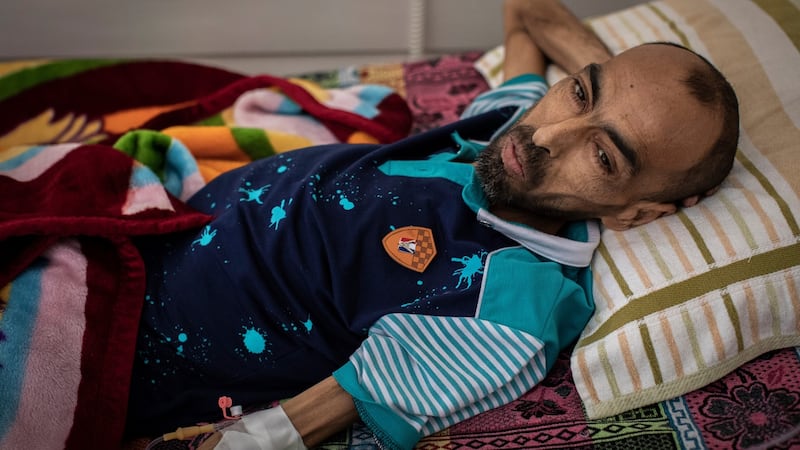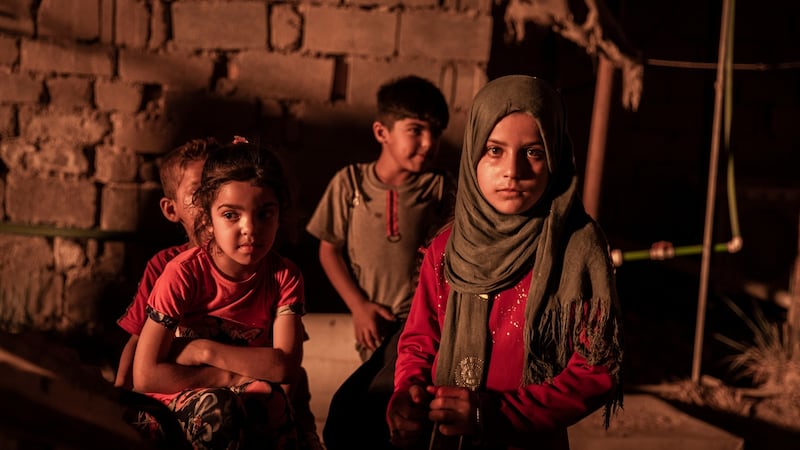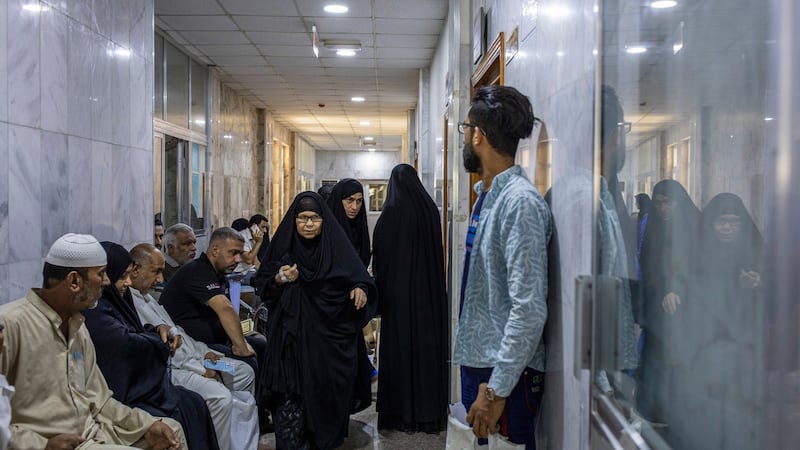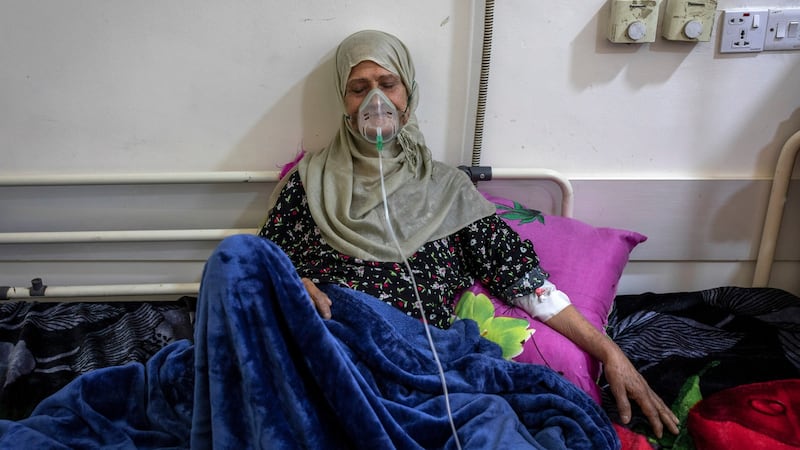The men of Nahran Omar, a village in the heart of southern Iraq's oil country, filed into a Shia shrine clutching envelopes with X-rays, medical reports and death certificates.
They had come to describe the misery they say is caused by the burning gas and chemicals spewing out of the oil wells in their village. Each one had a sick son or a dying wife, an ill brother or sister.
"Imagine that in the town you come from every family has someone who has cancer," said Khalid Qassim Faleh, a local tribal leader. "This is the situation in Nahran Omar."
The chemicals in the air – in Nahran Omar and other oil towns across southern Iraq – come from the smoky orange flames atop the oil wells, burning away the natural gas that bubbles up with the oil.
Many countries have reduced the practice, known as flaring, in part because it wastes a precious resource. The amount of gas Iraq flares would be enough to power three million homes, according to the International Energy Agency. But flaring also produces chemicals that can pollute the air, land and water.
It has been shown to worsen asthma and hypertension, contribute to the incidence of some cancers and speed climate change. Iraq, however, still flares more than half the natural gas produced by its oil fields, more than any other country except Russia.
The practice contributes to Iraq's bizarre energy paradox: a country with some of the world's largest oil and gas reserves faces a chronic power shortage and frequent blackouts. To feed its gas-powered electricity plants during the long, hot summers, it has to import gas, which it buys primarily from Iran.
Wasted resource
“Iraq could be self-sufficient,” said Ali al-Saffar, the head of the Middle East and North Africa division of the Paris-based International Energy Agency. “Instead it’s in a league of its own: it is unique because it flares gas at the same time that it imports it.”
As Iraq’s economy craters under the twin assault of collapsing oil prices and the coronavirus pandemic, it can ill-afford the several billion dollars a year it spends buying gas from Iran. The purchases also undercut US sanctions on Iran aimed at preventing it from selling oil and gas.
Iraqi officials acknowledge the need to reduce flaring but say that efforts to build expensive plants and pipelines to recapture gas from oil wells have been hindered by war and now by the dire economy. After the Islamic State terror group seized a third of the country in 2014, the battle against it required every bit of government revenue for several years.

In the last six months, crashing oil prices have deprived the government of its main source of revenue and the coronavirus pandemic has shut down much of the economy.
"So, okay, we respect people's criticism," said Iraq's former oil minister, Thamer Ghadban. "But let them come here and try to operate oil and gas plants under these circumstances."
Iraqi flaring releases as much as 30 million tons of carbon dioxide a year, nearly 10 per cent of the flaring emissions of the greenhouse gas worldwide
For years, recapturing the gas was not a priority, given the country’s seemingly endless oil supply and, until recently, fat oil profits. But that is changing, officials say. After years of delays, Iraq opened a large recapture plant in Basra in 2018 at a cost of an estimated $1.5 billion, according to oil industry experts. But the plant is only a first step: it recovers a little more than half of the gas from three large oil fields. There are 15 oil fields in Basra province alone.
The oil ministry announced plans last month to develop plants that would recover most of the gas that is now flared in southern Iraq. Ghadban said the projects would be operational in two to three years. International energy experts say that given Iraq’s economic troubles, those projections are wildly optimistic.
Dante’s inferno
Flying into Basra at night looks like a descent into Dante’s inferno: spires of flame cast pools of orange light in the darkness. A sizzling city – summer temperatures regularly the high 40s – of nearly three million people in Iraq’s southeastern corner, Basra and the surrounding province hold 60 per cent of Iraq’s proven oil reserves. But it was not the temperature that startled listeners of a morning weather forecast last August.
“We are sounding the alarm,” the weatherman said in what has become a familiar refrain. “Today there are poisonous gases in the skies of southern Iraq that can harm people. The poisonous gases are a result of oil and car exhaust.”
Gas flaring is not the only cause of pollution in the oil-rich southeast. Petrochemical plants, aging sewage plants, uranium from degrading weapons and materiel from recent wars all contribute to what Shukri Hassan, a professor of environment at the University of Basra, calls "a cocktail of pollutants".
“The air quality is really bad, water quality is also very poor, and there are many problems with the soil,” he said. “All of that makes Basra not a livable place.”

Flaring also wreaks havoc on the environment. Iraqi flaring releases as much as 30 million tons of carbon dioxide a year, nearly 10 per cent of the flaring emissions of the greenhouse gas worldwide. At the same time, flaring wastes clean-burning gas Iraq could use in its power plants, increasing its reliance on dirty oil-based fuel and compounding the environmental damage.
Iraq has decent environmental laws on the books, but no one enforces them, said Ali Shaddad al-Fares, a local builder and entrepreneur who heads the provincial council’s oil and gas committee. “The oil companies have committed to protect the environment but there is no government enforcement. It is their job to protect the people, but they aren’t doing it.”
Special hell
An hour outside of Basra, the village of Nahran Omar offers a glimpse of the special hell of life amid an oil field. The village, population about 1,500, comprises three hamlets along the banks of the Tigris river as it widens out before emptying into the Persian Gulf.
Sometimes when we get up early in the morning we see the oil rain on our clothes that were hanging out to dry for the night and our cars are spotted with it
The government found oil and built the first well there in the 1960s. Today five wells dominate the eastern end of the village.
The wells pump out a mix of oil, water and gas, primarily methane. The oil is channelled into tanks and pipelines to the port at Um Qasr. The oil-tainted water drains into a pond on the village’s outskirts, killing any life there. Nothing lives in the water, no grasses or plants grow nearby, even the desert birds avoid perching too close to it.
Flaring is just a cheap way to get rid of the methane, which would otherwise be an explosive hazard. Many oil-producing countries, including the United States, flare gas, but rarely close to homes. In Nahran Omar, the flares roar day and night, kicking out so much heat that the faces of people who live nearby look permanently sunburned.

The leaves of nearby trees curl brown on the sides that face the flares. Children born in Nahran Omar in the past decade have never known silence nor seen a dark night sky because the flares cast an unending, brilliant light over the surrounding landscape.
“We cannot breathe here,” said Beshir Aude el-Jabber, the village mukhtar or community leader. “If you want to breathe, you have to drive away from our village. For the children it is especially hard, their lungs are small. For the old people too, it is hard because their lungs are weak.”
The flares produce what the locals call oil rain, an oily precipitate made from the amalgam of water and hydrocarbons that do not completely burn during flaring and which, as it cools, absorbs water in the humid atmosphere. The breezes off the nearby Tigris carry the brew to nearby houses.
“The oil rain from the flares destroyed our gardens and we cannot plant anymore,” el-Jabber said. “Sometimes when we get up early in the morning we see the oil rain on our clothes that were hanging out to dry for the night and our cars are spotted with it.”
Oil is splattered on the corrugated metal roofs like pointillist paintings. The only way to remove it is with diesel fuel, Jabber said. Most families have a member who has had cancer. “My son died five years ago of lymphoma,” said Abu Beshir Nasir Shreggi (58), a teacher. “He was an athlete and very strong. He was like all the kids, he liked soccer.” He pulled out his cellphone and showed a photo of a boy in a yellow soccer jersey.
The company acknowledges that it is cheaper to pay the fines than to build another recapture plant, which can cost $1 billion or more
When his son got sick, Shreggi said he complained to a member of the provincial council, who suggested he send his son abroad for treatment. Shreggi laughed ruefully. “That would cost $50,000 and no one is going to give me the money,” he said. “And so my son is dead.”
Cancer cluster
Epidemiologists say there is a relationship between intensive petroleum production and some cancers, but in a place like Basra, with multiple sources of pollution, it is hard to draw conclusions about causality. The mix of hydrocarbons in oil rain can be carcinogenic, said Dr Marilyn Howarth, a senior fellow at the University of Pennsylvania's Centre of Excellence in Environmental Toxicology. "The oil itself can contain traces of heavy metals, arsenic and radioactivity, which could be a source of lung cancer," she said.
The byproducts of oil production can contribute to the risk of leukaemia, lymphomas, myeloma, and kidney and bladder cancer, said Dr Otis Brawley, a professor of oncology and epidemiology at Johns Hopkins. Oil workers may also be exposed to known carcinogens like asbestos, he said.

The Basra office of the ministry of health says that the rates of cancer in southern Iraq are only marginally higher than those elsewhere in the country – "about the same as for the rest of the region", said Dr Abbas Tamimi, the head of the Basra health department.
But he acknowledged that cancer deaths are underreported because of stigma attached to having cancer. Still, the number of cancer cases in Nahran Omar seems high by any standard, according to local politicians like Fares of the provincial oil and gas committee and cancer experts at Basra Hospital.
Jabber, the mukhtar, who has kept a meticulous table of local cases, said that in the last six years, 54 residents have died and another 33 are suffering from some form of cancer. That means about 6 per cent of the population has got cancer in that period.
About half of those who died were under 25, according to his records. In several instances, two people in the same family died of cancer. The most prevalent cancers in Nahran Omar are lymphoma, kidney cancer and breast cancer. Brawley, who is familiar with some of the contaminants in southern Iraq, said that Nahran Omar "sounds like a cluster" but that without comparative studies it would be difficult to say whether cancer rates there are higher than normal.
Toothless fines
The villagers have turned to government and quasi-government agencies for help to no avail. Among them: the Basra Oil Co, a state-owned enterprise that has a majority share in all oil production in southern Iraq; the provincial council's oil and gas committee, which was recently eliminated; and the Basra branches of the ministry of health and environment.
Senior officials at each of those institutions acknowledge that flaring wastes energy and degrades the air quality. The environment ministry, which five years ago was merged with the health ministry, has levied numerous fines against Basra Oil for a variety of violations including flaring beyond the legal limit. But the company acknowledges that it is cheaper to pay the fines than to build another recapture plant, which can cost $1 billion or more.
It was hot and sticky inside, and the electricity had gone off – a reminder that despite the oil and wealth being produced there, many locals see few benefits
"The ministry of environment imposed many penalties against us, but it's not easy to develop environmental protections because it requires so much investment," said Khalid Hamza Abbas, the company's senior chief engineer. "We have a plan to treat the gas, if we have the budget."
That is a big if. Iraq is now running a $2.5 billion deficit per month. And the plan would do little for the village of Nahran Omar. No recapture plant has been proposed for the five oil wells there. Despite the pollution and illness, no one there wants the oil wells to close.
When residents demonstrated against Basra Oil in 2018 it was to demand more jobs for local residents. The company hires very few locals once the wells are built. ‘We want you to employ us, to employ our sons,” Faleh, the tribal leader, said at his home on a sweltering evening. It was hot and sticky inside, and the electricity had gone off – a reminder that despite the oil and wealth being produced there, many locals see few benefits.
Faleh struggled to explain his feelings: he suffers from breast cancer and expects that he will die of it in a few years. But if the oil wells are killing villagers, he said, at least the industry could provide a livelihood. “You see our lives are over,” he said. “We want to do something for our children.” – New York Times









